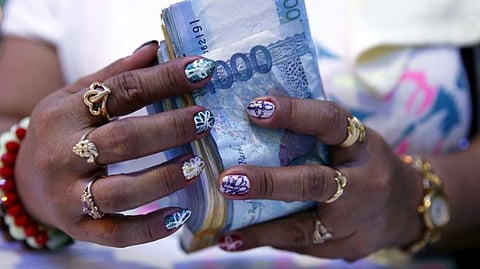Falling Peso hits debt-laden Philippine companies
The peso, among Asia's worst performers this year, will likely weaken by 2.4 percent in 2019

HIGHLIGHTS:
■ The Philippine peso is among Asia's worst performers so far in 2018 — it closed at 53.590 a dollar on October 30. A Bloomberg survey suggests it is likely weaken by 2.4 percent in 2019 to $1: 54.90 pesos and to 55 in 2020.
■ $4.9 billion in dollar bonds and loans of Philippine companies have matured or will still come due before end-2018.
■ This is more than 4 times the amount in 2017 — and the highest since at least 2003.
■ San Miguel Corp., SM Investments Corp. and Ayala Corp. are some of the leading groups with dollar-denominated obligations who need to refinance or repay in the next five years
■ Only just 30 percent of private dollar debt is hedged, according to one estimate.
Manila: The Philippines' biggest companies face another year of significant repayments of U.S. dollar debt after record amounts came due in 2018, even as a slumping peso makes it costlier to pay back.
A total of $4.9 billion in dollar bonds and loans have matured or will still come due in 2018, more than four times the amount last year and the highest since at least 2003, according to data compiled by Bloomberg.
Obligations that groups such as San Miguel Corp., SM Investments Corp. and Ayala Corp. need to refinance or repay in the next five years will remain sizable.
The Philippine credit market is seeing reminders of the late 1990s Asian financial crisis.
Big companies including banks and builders must pay back dollar debt at a time when the home currency is depreciating.
The peso, among Asia's worst performers this year, will likely weaken by 2.4 percent in 2019 to 54.90 pesos per dollar and to 55 the year after, according to a Bloomberg survey. It closed at 53.590 a dollar on Oct. 30.
Volatility
As currency volatility lingers, the Philippine central bank is closely monitoring corporate credit for risks it could pose to the financial system.
Huge exposure to foreign-currency debt, at a time when the peso has touched 12-year lows, could erode corporate profitability and add to banks' overall credit risks, the central bank said in an emailed reply to questions.
An exchange house staff counting Philippine pesos. Big companies including banks, brewers and builders must pay back dollar debt at a time when the Asian currency is depreciating. Bloomberg
This is especially true for companies that haven't sufficiently hedged their dollar obligations, it said.
Hedging is a method of covering a party's existing or future exposure to the risk of adverse price movements (like an exchange rate fluctuation) in an asset or variable.
Hedging levels
Probably only 20 percent to 30 percent of private dollar debt is hedged, excluding any natural cover from dollar earnings, according to Eduardo Francisco, president of BDO Capital & Investment Corp., which is engaged in securities underwriting, loan syndication and the financial advisory business.
No official numbers are reported to the central bank.
"Hedging levels have likely remained the same over the years because hedge cover has always been expensive," Francisco said. "The market is not that deep."
The most at risk from the peso slump are construction and transportation companies, whose revenues are in the local currency but they make large investments in dollars, according to S&P Global Ratings analyst Bertrand Jabouley.
San Miguel and its energy units have to pay off the most dollar debt in the next five years at $3.3 billion, based on publicly available data.
The conglomerate that had expanded to infrastructure enters into currency swaps to manage its long-term borrowings, according to regulatory filings.
The conglomerate and units including oil refiner Petron Corp. and SMC Global Power Holdings Corp. have been borrowing in pesos in the past three years to refinance dollar obligations.
The company declined to provide details of its hedging.
While hedge cover remains costly, companies like Ayala count on their dollar earnings to provide protection.
The conglomerate, whose banking, utility and telecom units face $1.5 billion in outstanding dollar debt to 2023, said in latest regulatory filings it is fully covered by its foreign currency assets.
"Despite the weakness of the peso against the dollar, Ayala did not incur materially significant debt-related foreign exchange losses" as of the third quarter, it said.
SM Investments vice chairman Teresita Sy-Coson said she doesn't expect the peso slump to have a great impact on the company's ability to service its debts.
"As long as we're hedged, we're OK. We've learned our lessons from the 1997 Asian financial crisis," she said. SM, which owns the Philippines' biggest bank and largest mall operator, has $1.9 billion in outstanding dollar debt in the next five years.
Sign up for the Daily Briefing
Get the latest news and updates straight to your inbox



